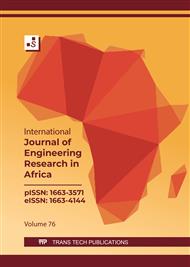[1]
E.A. Uchechukwu, J.O. Olakunle, S. Duna. "Characteristics of Ordinary Portland Cement Paste Containing Rice Husk Ash and Conplast." Journal of Building Material Science, 4(1), (2022) 1–10.
DOI: 10.30564/jbms.v4i1.4144
Google Scholar
[2]
R.T. Loto, A. Busari "Electrochemical study of the inhibition effect of cow bone ash on the corrosion resistance of mild steel in artificial concrete pore solution." Cogent Engineering, 6(1) (2019).
DOI: 10.1080/23311916.2019.1644710
Google Scholar
[3]
S. Liao, D. Wang, C. Xia, J.Tang. "China's provincial process CO2 emissions from cement production during 1993–2019." Scientific Data, 9(1), (2022)1–14.
DOI: 10.1038/s41597-022-01270-0
Google Scholar
[4]
I.H. Shah, S.A. Miller, D. Jiang, R.J. Myers. "Cement substitution with secondary materials can reduce annual global CO2 emissions by up to 1.3 gigatons". Nature Communications. 13(2022) 5758.
DOI: 10.1038/s41467-022-33289-7
Google Scholar
[5]
V. Shah. "Performance evaluation of carbonated cement paste derived from hydrated Portland cement based binders as supplementary cementitious material". Cement, 15 (2024)100091.
DOI: 10.1016/j.cement.2024.100091
Google Scholar
[6]
S.A. Miller, A. Horvath, P. J. M. Monteiro. (2018) "Impact of booming concrete production on water resources worldwide." Natural Sustainability. (1) (2018) pp.69-76.
DOI: 10.1038/s41893-017-0009-5
Google Scholar
[7]
F.N. Costa, D .V. Ribeiro. "Reduction in CO2 emissions during production of cement, with partial replacement of traditional raw materials by civil construction waste (CCW)." Journal of Cleaner Production. 276, (2020)123302.
DOI: 10.1016/j.jclepro.2020.123302
Google Scholar
[8]
L.D. Ellis, A.F. Badel, M.L. Chiang, R.J.Y. Park, Y.M. Chiang. "Toward electrochemical synthesis of cement—An electrolyzer-based process for decarbonating CaCO3 while producing useful gas streams", Proceedings of National Academic of Science. U S. A. (117) (2020) 12584–12591.
DOI: 10.1073/pnas.1821673116
Google Scholar
[9]
A. Scott, V. Shah, C. Oze, B. Shanks, C.R. Cheeseman. "Use of olivine for the production of MgO-SiO2 binders". Frontal for Built Environment 7 (2021).
Google Scholar
[10]
M. Simoni, T. Hanein, C.L. Woo, J. Provis, H. Kinoshita. "Effect of impurities on the decarbonization of calcium carbonate using aqueous sodium hydroxide". ACS Sustain. Chem. Eng. (10) (2022) 11913–11925.
DOI: 10.1021/acssuschemeng.2c02913
Google Scholar
[11]
J.O. Akinyele, U.T. Igba, J.O. Labiran. "Durability Problems of Reinforced Concrete Structures on the Lagos Lagoon in Nigeria". Smart & Sustainable Infrastructure: Building a Greener Tomorrow, RILEM book series (48) (2024) 629-640.
DOI: 10.1007/978-3-031-53389-1_57
Google Scholar
[12]
U.T. Igba, J.O. Akinyele, F.M. Alayaki, S.I. Kuye and S.O. Oyebisi. "Deterioration and Microstructural Characterization of Reinforced Concrete Beam Buried in Lagoon and Fresh Waters". Nigerian Journal of Technology (NIJOTECH) 40 (2) (2021) 177-185.
DOI: 10.4314/njt.v40i2.2
Google Scholar
[13]
A.M. Neville, J.J. Brooks. Concrete Technology, 2nd Edition (2010). Prentice Hall, Pearson Educational Ltd. England.
Google Scholar
[14]
N.P. Asrani, G.Murali, H.S. Abdelgader, K. Parthiban, M.K. Haridharan, M.K. Karthikeyan, "Investigation on Mode I Fracture Behavior of Hybrid Fiber-Reinforced Geopolymer Composites". Arabian Journal of Science and Engineering, 44(10) (2019) 8545–8555.
DOI: 10.1007/s13369-019-04074-4
Google Scholar
[15]
J. Davidovits. "Geopolymer, Chemistry and applications" 5th Edition (2020). Institute Geopolymer, Saint-Quentinn, France.
Google Scholar
[16]
B.V. Rangan. "Low-Calcium Fly-Ash based goepolymer concrete". Concrete construction Engineering Handbook. 2nd Edition (2008). CRC Press, New York.
DOI: 10.1201/9781420007657.ch26
Google Scholar
[17]
J. Davidovits. Review Geopolymer Cement (2013) (1-11). Institute Geopolymere, Saint-Quentinn, France.
Google Scholar
[18]
K. Vijai, R. Kumutha, B.G. Vishnuram. "Effect of types of curing on strength of geopolymer concrete", International Journal of Physical Scence. 5(9) (2010)1419–1423.
Google Scholar
[19]
F.H. Zaidi1, R. Ahmad, M. M. Al, B. Abdullah, M. F. M. Tahir, Z. Yahya, W. M. W. Ibrahim, A. S. Sauffi. Performance of Geopolymer Concrete when Exposed to Marine Environment. (2019) IOP Conf. Ser.: Mater. Sci. Eng. 55.
DOI: 10.1088/1757-899x/551/1/012092
Google Scholar
[20]
J. Moore, Reinforced geopolymer concrete for marine application. B.Eng. Dissertation, (2022) Murdoch University. Australia.
Google Scholar
[21]
D. Hardjito. "Studies Fly-ash based Geopolymer concrete", Unpublished PhD thesis (2005), submitted to the Department of Civil Engineering, Curtin University of Technology, Australia.
Google Scholar
[22]
BS EN 1744-1: (2009). Tests for chemical properties of aggregates - Chemical analysis. British Standard Institution, London.
Google Scholar
[23]
BS EN 12390-3: (2019), Testing Hardened Concrete. Compressive Strength of Test Specimens. British Standard Institution, London.
Google Scholar
[24]
BS EN 12390-6: 2019. Testing hardened concrete Tensile splitting strength of test specimens British Standard Institution, London.
DOI: 10.3403/02128962
Google Scholar
[25]
BS EN 12390-5: 2019. Testing Hardened Concrete: Flexural Strength of Test Specimens, BSI, London.
Google Scholar
[26]
T.Y. Koledoye, B.Akinsanya, K.O. Adekoya, P.O. Isibor. "Physicochemical parameters of the Lekki Lagoon in relation to abundance of Wenyonia sp Woodland, 1923 (Cestoda: Caryophyllidae) in Synodontis clarias (Linnaeus, 1758), Environ. Challenges, 7 (2022) 100453-100453.
DOI: 10.1016/j.envc.2022.100453
Google Scholar
[27]
C.H. Rüscher, E. Mielcarek, W. Lutz, A. Ritzmann, W.M. Kriven "Weakening of Alkali-Activated Metakaolin during investigation by Molybdate Method and Infrared Absorption Spectroscopy". Journal of American ceramic Society. 93 (9) (2010) 2582-2590.
DOI: 10.1111/j.1551-2916.2010.03773.x
Google Scholar
[28]
BS 8500-2 (2023) Specification for constituent materials and Concrete. British Standard Institution, London
Google Scholar
[29]
D.D. Burduhos-Nergis, M.M.A.B. Abdullah, P. Vizureanu, M.M. Tahir. Geopolymers and their uses. In IOP Conference Series: Materials Science and Engineering, 374, (2018) 012019.
DOI: 10.1088/1757-899x/374/1/012019
Google Scholar
[30]
M. Lahoti, K.H. Tan, E.H. Yang, "A critical review of geopolymer properties for structural fire-resistance applications". Construction and Building Materials, 221, (2019) 514-526.
DOI: 10.1016/j.conbuildmat.2019.06.076
Google Scholar


